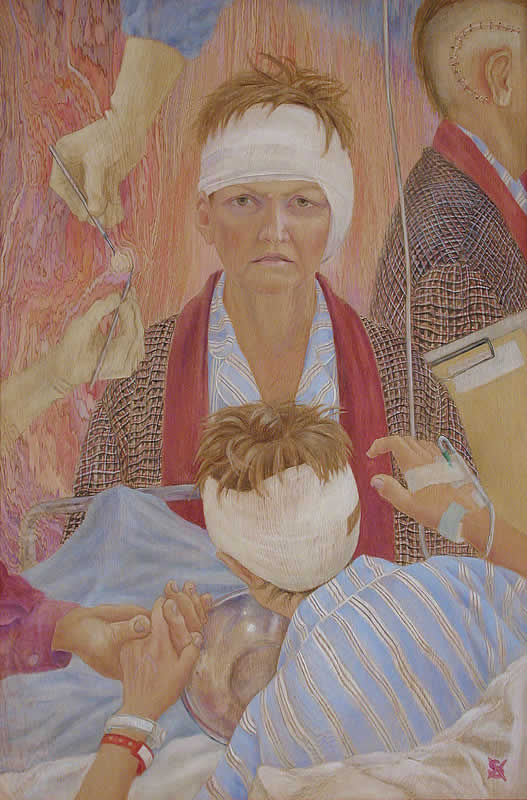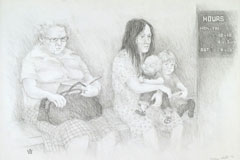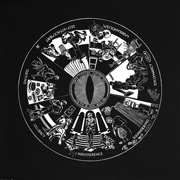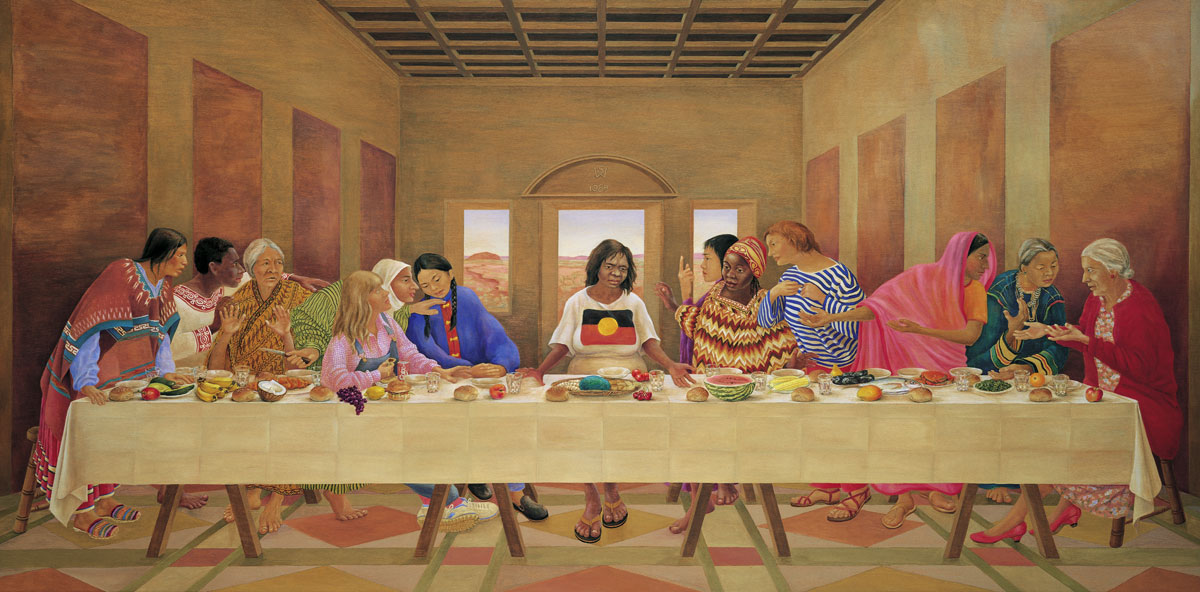Ed McCormack (New York
Art Reviews

Strong social satirist
Andrew Margolis, Gallery & Studio, New York, 1998Susan Dorothea White, an internationally exhibited painter and sculptor from Australia whose work is in the National Gallery, among other prestigious public and private collections, explores the most intimate experiences of her life, as well as more topical subjects, in meticulously limned acrylic paintings on wood panels. Her ability to examine unflinchingly such personal milestones as her surgery for a benign brain tumor with a dazed self-portrait in a vertiginously askew hospital setting results in some of the most emotionally jarring narrative imagery in recent art. However, her work can also be informed by an appealing light-heartedness, as seen in her whimsical picture of her professorial husband suspended in mid-air with a book seeming to take flight, like a startled bird, from his hands.
She is also a strong social satirist, particularly in paintings such as The Crowning with Sexism, which combines iconographic images of Marilyn Monroe and Joe DiMaggio with a composition borrowed from Hieronymus Bosch, as well as in other Boschian extravaganzas such as The Seven Deadly Sins of Modern Times and The Seven Deadly Isms. The latter work is mounted on a circular table and comprised of several interconnecting compositions depicting such contemporary obsessions as Materialism and Workaholism in intricate figurative tableaux.
Susan Dorothea White's use of unusual materials such as endangered and recycled woods native to Australia contributes significantly to the effectiveness of her work, with the grain showing through her translucent glazes in her paintings and the surface skillfully carved in mixed media sculptures such as It Cuts Both Ways. In the latter sculpture, black and white clasping hands morph into lethal-looking shears, while in White's bronze maquettes for monumental fountains, natural phenomena are imaginatively transformed through the artist's fluid handling of shapes in space.
Gallery & Studio (New York), Andrew Margolis, Nov/Dec. 1998
Extraordinary artist
Ed McCormack, critic, New York, Sept. 1998» View selected work from this exhibition
Susan Dorothea White is an extraordinary artist and her exhibition at Montserrat is a truly magnificent show. I have not seen narrative paintings to compare with these in quite some time, perhaps never in recent times.
Clarity and psychological insight
Judges Report, Portia Geach Memorial Award, Sydney 1997» View selected work from this exhibition
On Me After Brain Surgery: ".. its complex intensity in using a delicate technique to deal with a difficult subject matter with clarity and psychological insight."

Qualité, beauté, originalité
Arstances, Nice, 2000» View selected work from this exhibition
Le symbole est son concept dans la réalisation de son oeuvre, l'image de l'être se traduit en un masque de bronze s'étirant par des mains libératrices de la vision sur le monde ou une paire de ciseaux se transpose en une paire de bras. Objets—humains. Cette réalisation est personnelle liée à une esthétique de pensée jouxtant le sentiment intimiste. Qualité, beauté, originalité – Susan Dorothea White traduit ses compositions dans une lisibilité franche pour le comtemplateur.
TRANSLATION
Quality, beauty, originality.
The symbol is the artist's concept in the realization of her work: the essence of being is represented as a bronze mask stretched out by hands liberating it from the vision of the world or a pair of shears is shown metamorphosing into a pair of arms. Objects—Humans. This realization is personal; it is tied to a thoughtful aesthetic akin to that of intimism. Quality, beauty, originality – the compositions of Susan Dorothea White convey her frankness and openness to the onlooker.
Arstances (Nice) Jan/Feb. 2000

Prestigious Hechinger Collection
Gallery & Studio, New York, Jan/Feb 2000» View selected work from this exhibition
It Cuts Both Ways, a mixed media sculpture that we reviewed favorably in an earlier issue of Gallery & Studio, when artist Susan Dorothea White exhibited it in her solo show at Montserrat Gallery in Soho, was recently purchased by the prestigious Hechinger Collection and exhibited at the National Building Museum in Washington D.C.
Bold Sculpture
Sarah Tanguy, Curator, Hechinger Collection, Washington DC, 2002» View selected work from this exhibition
"Referring to the balance between gender and races, the bold sculpture It Cuts Both Ways suggests that 'any potential movement of either pair of hands would activate both pairs equally'. To realize the piece, she replaced the handles of garden shears with hands carved from salvaged huon pine (which can take up to 3,000 years to grow!) and modified found clothing for the sleeves..."
Tool time sublime
Alan J. Heavens, The Philadelphia Inquirer, March 2002» View selected work from this exhibition
A Washington exhibit turns tools into creative jewels
....Tools can also make a statement seemingly unrelated to work. Susan D. White uses two hedge clippers... at either end in It Cuts Both Ways, a commentary on racial harmony.

Equally talented and skillful
Dorothy Roatz Myers, Art Talk, New York, 1994» View selected work from this exhibition
Susan Dorothea White is an artist equally talented and skillful as a printmaker, a sculptor, and a painter. Her works were well received by the art community and critics when they were recently exhibited here in New York at the Montserrat Gallery, 584 Broadway (SoHo).
White's prints carry important sociological messages as exemplified by The Seven Deadly Sins, somber and serious, done entirely in black and white in a zodiac-like format. The center circle, 'The Eye of Gaia Sees All', is the core of the message. The seven deadly sins are illustrated in sections around the outside edge of the circle: they are self-effacement, workaholism, sycophancy, squandering, indifference, celibacy, and dieting. Her wry humor shows a bit here.
Her rendering is simple and clear, readily interpreted; colors are clean and pure. Symbolism rather than situation portrayal typifies White's style. We are shown a man's bare feet on a tile floor beside a newspaper and milk bottles in The Front Verandah. To Let is similar. In it a man sits by an iron grillwork gate reading the paper. An ad torn from the classified section, a house number, and a page from the newspaper are composed behind and around him... here, too, the message is obvious. Blind is poignant with three blind figures making their way on what appears to be steps, possibly symbolic of cooperative attainment.
Humor, more pointed than funny, is the thread of continuity throughout Susan Dorothea White's art, regardless of medium. A case in point is The Long Arm of the Law. It is created with exactly what the title states... a very long black-robed arm extends out into the gallery room with a legal document in its hand! The table-top sculptures are sophisticated and titillating... Close-knit Family – family members' heads are "knitted" together... To Cut Both Ways – crossed scissor blades are sharpened on both edges... Shy Egg is attempting to conceal itself, and Stretching the Imagination depicts distorted features – stretched eye sockets.
Susan Dorothea White has exhibited her art consistently since studying at the South Australian School of Art. Her work has appeared in solo exhibitions, group exhibitions, and international biennales in Germany, Spain, Australia, Italy, China, Poland, Canada, Yugoslavia and France. Her work is in public, private and museum collections worldwide. She is cited in Who's Who in International Art.
Art Talk (New York), Dorothy Roatz Myers, July 1994
'Jüngerinnen' beim Abendmahl
Der Weg, Cologne, 1991» View selected work from this exhibition
Eine ungewöhnliche Interpretation der Abendmahlszene is zur Zeit in der Kölner Galerie am Buttermarkt zu sehen: Jesus ist in dieser Darstellung eine Frau, eine Ureinwohnerin Australiens. Links und rechts neben ihr sitzen ihre 'Jüngerinnen': Frauen aus allen Erdteilen dieser Welt. An ihren Füßen erkennt man die soziale Stellung der Frauen. Manche tragen Schuhe, andere laufen barfuß. The First Supper nennt die australische Malerin Susan White ihr Bild and macht damit deutlich, daß sie die üblichen Vorstellungen vom 'letzten Abendmahl Jesu' ablehnt.
TRANSLATION:
'Female Disciples' at the Last Supper
An unusual interpretation of the painting The Last Supper is currently on view at Cologne's Am Buttermarkt Gallery: in this portrayal Jesus is a woman, an Australian aboriginal. Her 'female disciples' are sitting to her right and left: women from all corners of the world. Their feet reveal the social positions of the women – some are wearing shoes, others are barefoot. The Australian artist Susan White calls her painting The First Supper, which indicates clearly how far removed her concept is from the usual 'last supper of Jesus'. The exhibition of the Australian artist is currently showing in the gallery, Buttermarkt 23, until 11 April.
Der Weg (Cologne) Mar. 1991

Controversial Australian painting
Interview - Radio Netherlands Worldwide (RNW) with Nevil Gray, Images, 1991» View selected work from this exhibition
Nevil Gray (NG):... and we'll tell you about a controversial Australian painting which has found a home, and acceptance, in Europe. All that in Images, coming up...
Susan Dorothea White is an Australian painter, sculptor and printmaker. Born in Adelaide, she began her art studies there, going on to the Julian Ashton Art School in Sydney, where she lives and works today. She has participated in many exhibitions since 1957 and has represented Australia in many international exhibitions, from Yugoslavia, Budapest, Poland, France, Brazil, Japan, Italy, The Republic of China, Spain, Canada, and Korea. Her work is especially popular in Europe, and she recently had a major exhibition in Holland in Amsterdam's Art & Architecture Gallery, which has since moved on to Cologne in Germany to Galerie am Buttermarkt. Her exhibition of acrylic works on wood, lithographs and wood, stone, and bronze sculptures, attracted a lot of attention.
... read moreSusan White - veelzijdig werk
Kunstbeeld, Amsterdam, 1990» View selected work from this exhibition
Van beeldende kunst uit Australië weten wij hier betrekkelijk weinig af. Toch kent dit werelddeel enkele instituten van naam waar jonge mensen een degelijke opleiding krijgen in de verschillende beeldende disciplines. De South Australian School of Art en de Julian Ashton Art School in Sydney zijn twee van die instituten. Het zal niet verwonderen dat juist daar de relaties gelegd worden tussen de geschiedenis van de Europese beeldende kunst eb datgene wat aan eigen beeldend vermogen aanwezig is, onder eigen specifieke omstandigheden, hoe ver de afstand ook letterlijk is.
READ MORE AND ENGLISH TRANSLATION...
... read moreZentrales Thema is der Mensch
Dr. Anton Wernig, Galerie Arndt, Munich, 1980» View selected work from this exhibition
Susan White hat eine eigene Art von Realismus entwickelt, in welchem – wie in einer Fuge – ein Thema in einem Bild mehrmals bearbeitet wird. Ihre Themen nimmt die Künstlerin aus dem Leben der Familie, aus Erlebnissen in ihrer Heimat Australien und Reiseeindrücken (beispielsweise aus Bayern), sowie aus Allegorien und aus der Geschichte. Ihr zentrales Thema is der Mensch, wie es in The Retired Mechanic, The Empty Chair, The Children's Hospital und Two deutlich wird. In vielen Arbeiten, wie in The Gardener's Dream, The Magic Pudding und The Wishful Fisherman, werden die Wunschträume eines Menschen, oft genug die Phantasien eines Kindes, mit nachdenklicher Heiterkeit gezeichnet. Leichte Ironie findet sich in Noah's Rocket und The Nun and the Knight on the Train to Rothenburg.
READ MORE AND ENGLISH TRANSLATION
... read more